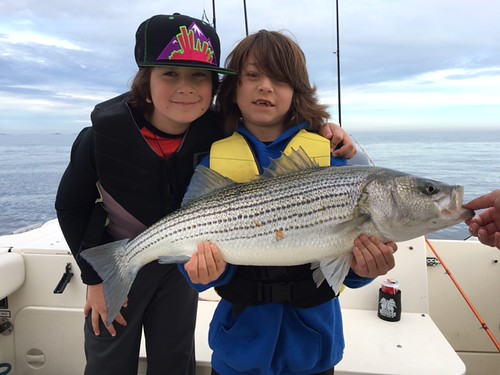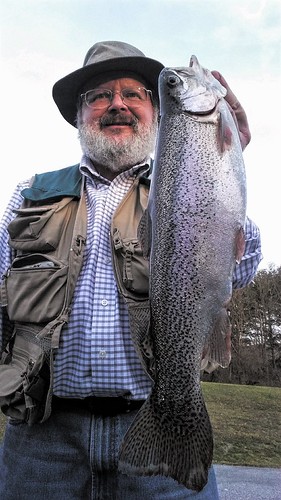More than a few have been taking advantage of the mild weather and late season fishing action. Unseasonably warm weather and light winds have made for some excellent fishing opportunities out on the open waters of the Chesapeake Bay and Atlantic Ocean as well as smaller freshwater areas. Colder weather is sure to be upon us in the near future so don't miss out.
Anyone fishing in the Conowingo Dam pool or the lower Susquehanna can't help but notice there has been very little water coming through the dam in the past couple of months. This has generally been a good thing for the bay's water clarity. Upper bay fishing for striped bass is toning down as one would expect as we approach the end of December. Balmy days and calm winds are enticing anglers to continue trolling along channel edges with a mixed spread of medium sized lures and larger presentations for a chance at one of the large fall migrant striped bass that have been frequenting the channel edges just above the Bay Bridge and the Dumping Grounds. A mix of bucktails, swim shads, parachutes and spoons have all come into play and all are being pulled behind large inline weights to get down to where the fish are holding along 35' to 40' channel edges.
Breaking fish action is pretty sparse these days in the upper bay since most of the bay anchovies and small menhaden have moved farther south looking for warmer water conditions. There are some nice sized striped bass holding along channel edges at the mouths of the major tidal rivers and main bay channels but they tend to be spread thin so trolling has been the most productive option. The Bay Bridge and the Key Bridge are two exceptions where jigging and live lining eels has been productive near the bridge piers. White perch can also be used for live lining as Rich Watts proves with this nice striped bass caught along a channel edge with a live perch.

Photo by Angelina Watts
White perch are holding deep in many of the channel areas of the upper bay and near the Bay Bridge. When they can be spotted on a depth finder; jigging or using a bottom rig baited with pieces of bloodworms are good options. Yellow perch fishing has improved in the upper bay in many of the tidal rivers such as the upper Bush, Northeast and lower Susquehanna. Small minnows on a bottom rig or small jigs are good baits to use. As upper bay tidal river waters become colder the yellow perch will be found in increasingly deeper waters.
In the middle bay region there are still plenty of striped bass to be found along main channel edges on the western and eastern sides of the bay. Classic steep channel edges such as Bloody Point, the False Channel at the mouth of the Choptank on the eastern side and the west side of the shipping channel from Breezy Point south. A mix of school sized and large fall migrant striped bass are being found along these edges in about 40' of water. Large lures such as Mojos, bucktails and parachutes dressed with sassy shads have been the most popular choices when trying to entice a large fall migrant. Medium sized bucktails, swim shads and spoons have been popular choices for school sized fish either in tandem or behind umbrella rigs. All are being pulled behind inline weights to get them down to where the fish are holding. Keith Stouffer caught this beautiful 40 lb striped bass on the steep channel edge at Bloody Point by trolling a large parachute dressed with a sassy shad.

Photo Courtesy of Keith Stouffer
At times the striped bass that are suspended near the channel edges are concentrated enough that light tackle jigging can be productive. In many areas the fish tend to be holding near the 40' edges of the shipping channel. In most cases with light winds and calm waves 2 to 3 ounce metal or soft plastic jigs are enough to get down to the fish. White perch are also often holding in these same water depths and the larger perch will hit the metal jigs at times.
The lower bay offers some of the best striped bass fishing to be found in Maryland waters this week. There are still some breaking fish to be found as the last schools of bait travel south through the region. The surface action is mostly made up of smaller striped bass but often larger fish can be found underneath. Light tackle jigging and trolling deep have been the most effective methods for targeting the striped bass holding deeper. The steeper channel edges of the shipping channel and similar edges in the lower Potomac River are good places to look for the best striped bass fishing. In these areas the tidal currents gain speed along the steep edges and sweep bait towards striped bass that are suspended there waiting for a meal.
The newest and perhaps most exciting new players in the lower bay striped bass fishery are the influx of large fall migrant striped bass. Most are being caught by trolling large mojos, bucktails and parachutes dressed with sassy shads along the steeper channel edges where these larger striped bass are feeding. It often takes a fair sized inline weight to get to the depths where the striped bass are holding and the less water resistance of braided line is a big help. These larger striped bass can also be caught while jigging; often on large soft plastic jigs and certainly test any fishermen's abilities on light tackle. Levi Shum is all smiles with this beautiful 34" striped bass he caught while jigging a soft plastic jig near Point Lookout on his grandfather's boat.

Photo Courtesy of Levi Shum
Freshwater fishing for a variety of fish species continues to be good this week. Colder water temperatures have changed the game quite a bit but anglers can find plenty of action if they follow the fish. Largemouth bass are holding in deeper waters now and are feeding close to the bottom. Fishing along drop-offs and deep structure such as sunken wood, rocks and bridge piers is a good tactic. Slow rolling spinnerbaits along the bottom or working jigs, blade lures and crankbaits close to the bottom will get one to where the fish are holding.
In the upper Potomac River large smallmouth bass are holding in some of the holes behind large rocks that break up the current and walleye are also active. A variety of jigs, crankbaits and jerkbaits are good lures to consider when fishing these areas. Water flows in the upper Potomac are low at this time. At Deep Creek Lake there is still plenty of "soft water" fishing to be found. The fair weather Maryland has been experiencing lately makes it hard not to get out on the lake and enjoy working the mouths of coves and existing grass for a mix of largemouth bass, chain pickerel, northern pike and yellow perch. Crappie are schooled up near the bridge piers and walleye can be found near the steeper rocky shores towards the evenings. It does not look like Deep Creek will be frozen anytime soon but January may be another story.
Recent surveys at Deep Creek Lake by fisheries biologists revealed that the majority of legal sized walleyes in Deep Creek Lake are between 15" and 18" in size. The survey also showed that the yellow perch fish populations are well balanced and smallmouth bass were the third most abundant fish in the lake. Largemouth bass populations continued to show an increase.
The trout management waters that were stocked in October and November still have trout to be caught. Fishing with small lures such as spinners, spoons flies will help one cover more water in search for trout that have spread out. Michael Day was casting a Mepps spinner at Blairs Valley Lake when he caught this nice rainbow trout recently.

Photo Courtesy of Michael Day
Fisheries Service hatchery staff are busy at the trout hatcheries this month. The next production cycle is underway as trout eggs are being cultured and trout fry are being carefully looked over. The Albert Powell Hatchery received 100, 000 brown trout eggs, 50,000 golden trout eggs and 80,000 rainbow trout eggs in November to get the new production underway for future trout seasons. Trout of all sizes are being reared at the two major hatcheries and also two satellite hatcheries to make sure there are plenty of trout, including the trophy sized trout for the upcoming trout seasons.
Fishing for blue catfish in the tidal Potomac River remains good this week and offers a lot of fishing action and good eating for relatively little effort. Anchoring up near channel edges and fishing with cut bait on a bottom rig is simple fishing. Channel catfish are still active in many of the tidal rivers flowing into the Chesapeake and can be caught on cut bait. Chain pickerel love cold water and are very active in the upper reaches of the tidal rivers and many impoundments throughout Maryland.
Ocean City area fishing continues to be mostly focused on the southerly migration of striped bass and sea bass fishing this week. The migration of large fall migrant striped bass through Maryland waters has been underway for a while now as the fish push south. There is a lot of bait off Ocean City beaches near various shoals and at times the striped bass are there also. Most are trolling large mojos, parachutes and Stretch 25's, jigging or drifting live eels. All know that one must stay within the 3-mile limit and to stay out of the EEZ Zone. Some of the action has been about 2 miles offshore so it pays to be careful and always know your position.
Surf casters have been getting in on some of the action using large cut baits of fresh menhaden or by casting large surface lures or swimming plugs. There is action at the Ocean City Inlet in the evenings and striped bass are being caught most every night on a variety of swim shads, bucktails or by drifting live eels.
The sea bass fishery out at the wreck and reef sites remains very good and limit catches are often the norm. Large bluefish continue to be in the region and continue to attack sea bass being reeled to the surface. Speed reeling is a good option to avoid coming up with just the head of your sea bass. The 2016 tautog season opens on January1st and the 2015 sea bass ends December 31st.

No comments:
Post a Comment